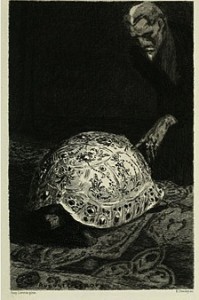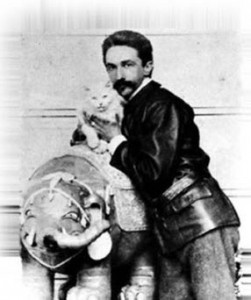By Rachel Mesch (Regular Contributor)
In novelist Joris-Karl Huysmans’ 1884 Against the Grain (À Rebours), the world-weary aristocratic protagonist Jean des Esseintes suffers from an acute case of fin-de-siècle ennui. He thus retreats into his estate on the outskirts of Paris, determined to live a solitary life of aesthetic contemplation.
Des Esseintes has little trouble keeping himself entertained in his home, which is filled with well-chosen objects and custom décor: in addition to an extensive book collection in French and Latin and a caged cricket to remind him of his childhood, he has a built-in aquarium whose water’s colors can be altered to suit his aesthetic predilections, and a “liquid organ” that synesthetically matches tasty liquers to musical symphonies. In one of the novel’s most memorable episodes, the tortoise that Des Esseintes had purchased fails to sufficiently awaken the hues of the oriental carpet that the creature was meant to throw into relief. Frustrated, he has it glazed with gold and then with rare gems, only to discover, hours later, that the animal has died from the unnatural weight imposed upon his bejeweled carapace.
An eccentric character? Certainly. The product of a hyperactive literary imagination? No doubt.
But Des Esseintes’ sensual passion for decorative objects and interior design was actually so familiar to late nineteenth-century life that numerous of Huysmans’ colleagues were credited with being the inspiration for the fictional character—including Charles Baudelaire (whose poetry adorns the character’s bedroom). Certain descriptions of Des Esseintes’ home were likely based upon the residence of dandy extraordinaire Robert de Montesquiou, whose own abode had a “moon room” meant to inspire new sensations, a spider garret, and a peacock themed library (although Huysmans had apparently never met the man personally). (1)
In other words, Huysmans’ eccentric protagonist wasn’t exactly one of a kind. During a time when making one’s own life into a work of art had become a veritable (anti?) social movement, his behavior was very much on trend.
It’s not hard to see, from these descriptions, why a penchant for purchasing pricey knick-knacks might place one at the precarious boundaries of psychological health in nineteenth-century France. In the 1890s, Husymans’ friend Edmond de Goncourt described this excessive collecting as bric-a-brac-o-mania (a term that Balzac had actually first used in the 1846 novella Le Cousin Pons). Goncourt noted that this passion now preoccupied “nearly an entire nation”—all those fellow troubled souls working against the “sadness of contemporary life and the uncertainty of tomorrow.” (2) Goncourt equated the pleasures of purchasing power with the best lovers; he embraced the “disease” as central to a decidedly modern artistic identity—one well-suited to this brave new era of immediate gratification.
Over a hundred years later, scholars of this time period are left not so much with the sadness of troubled souls but rather the intriguing remnants of early consumer culture. This new monthly column at Wonders & Marvels will be zooming in on some of those fascinating objects. We will explore how they inform research on the borders of nineteenth-century French literature, history, material, and visual cultures. As we examine various forms of archival bric-a-brac—from magazines to postcards to perfume bottles to books—we’ll look into the stories around them that drive innovative new research projects. We’ll also reflect on our scholarly penchants for collecting, and the modern tools that allow us to indulge our own bric-a-brac-o-mania, twenty-first-century style. Stay tuned!
1. For more about Robert de Montesquiou, as well as lots of juicy details about his home and those of many other writers, see Elizabeth Emery’s beautifully illustrated and highly informative study, Photojournalism and the Origins of the French Writer House Museum (1881-1914), published by Ashgate in 2012.
2. Edmond de Goncourt, La Maison d’un artiste. 2 vols. Paris: G. Charpentier, 1881.
 Rachel Mesch is our newest Regular Contributor on Wonders & Marvels. She teaches French literature, history, and culture at Yeshiva University in New York. You can hear her speak about her most recent book, Having it All in the Belle Epoque: How French Women’s Magazines Invented the Modern Woman, on the New Books in French Studies podcast or see some of the fun images in this photo essay from Slate.com. She is also the author of The Hysteric’s Revenge: French Women Writers at the Fin de Siècle and serves as an Associate Editor of Nineteenth-Century French Studies.
Rachel Mesch is our newest Regular Contributor on Wonders & Marvels. She teaches French literature, history, and culture at Yeshiva University in New York. You can hear her speak about her most recent book, Having it All in the Belle Epoque: How French Women’s Magazines Invented the Modern Woman, on the New Books in French Studies podcast or see some of the fun images in this photo essay from Slate.com. She is also the author of The Hysteric’s Revenge: French Women Writers at the Fin de Siècle and serves as an Associate Editor of Nineteenth-Century French Studies.



